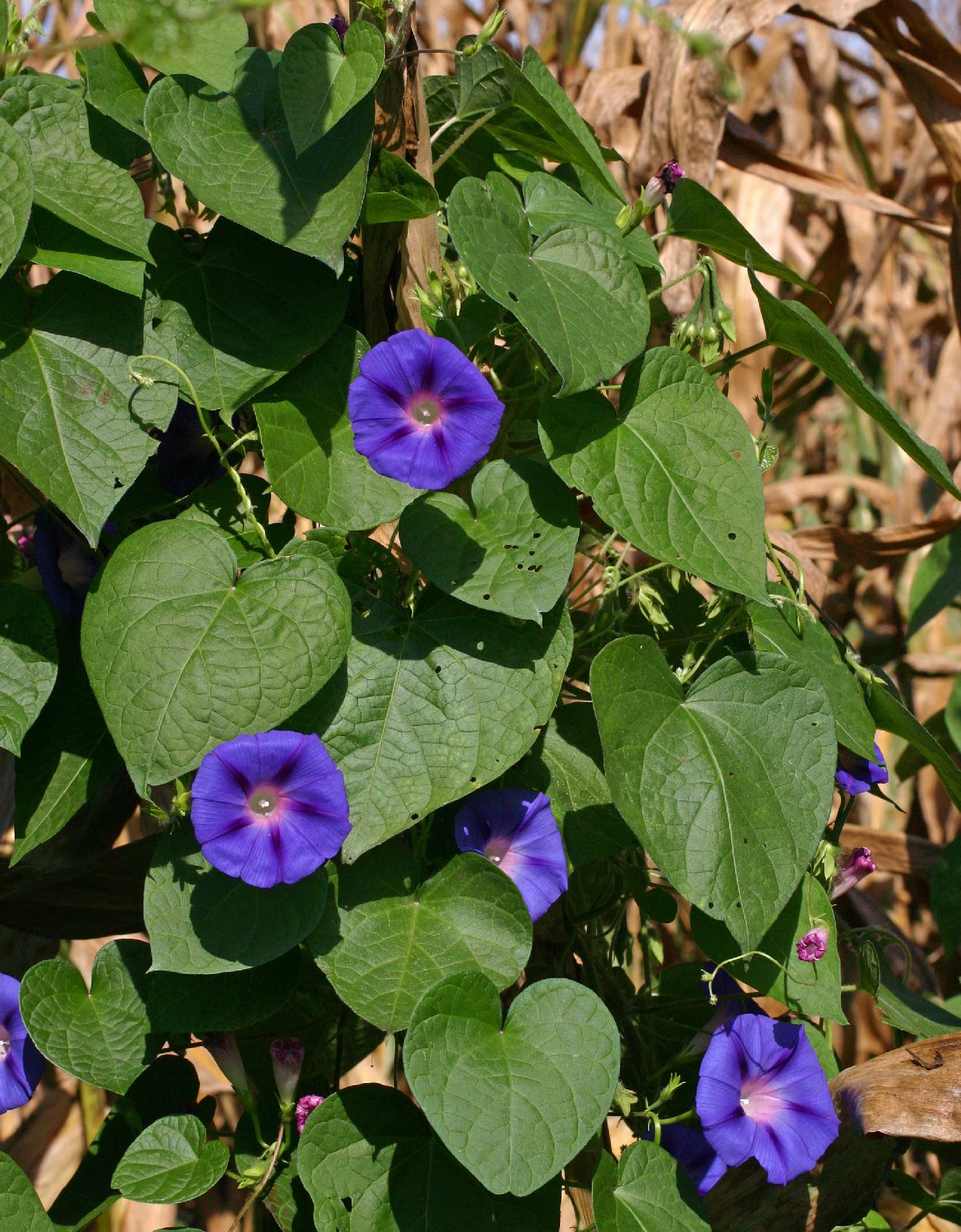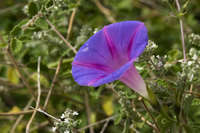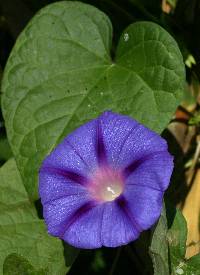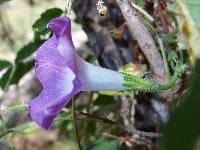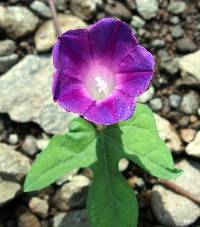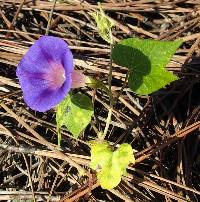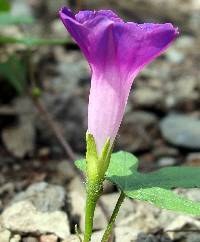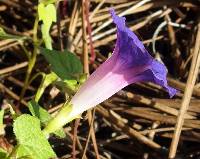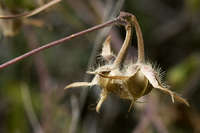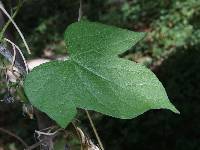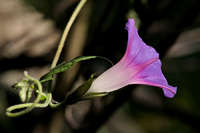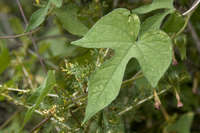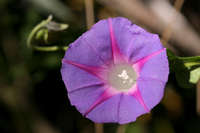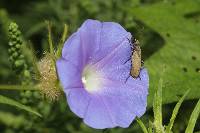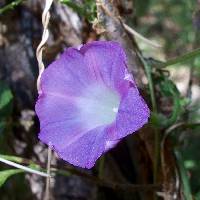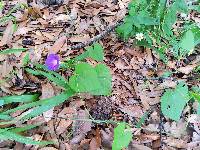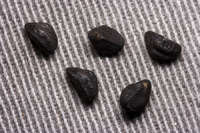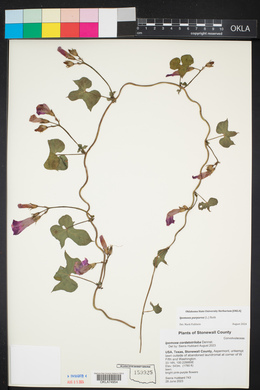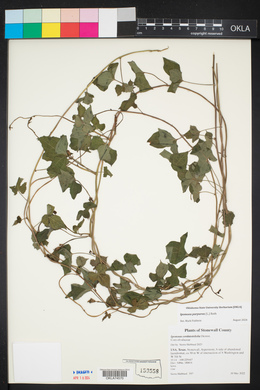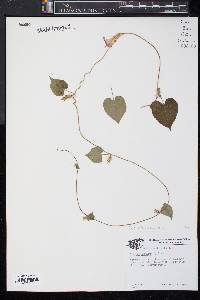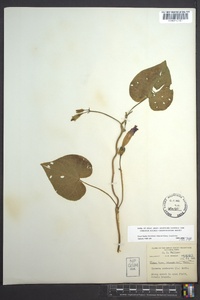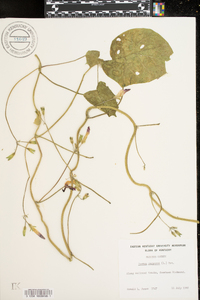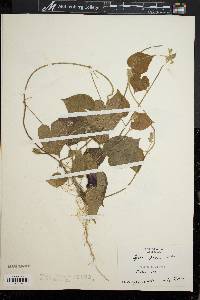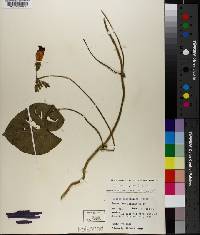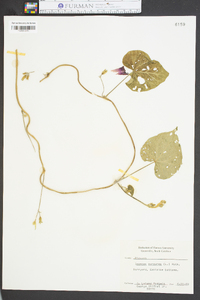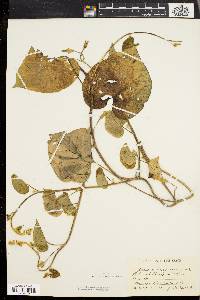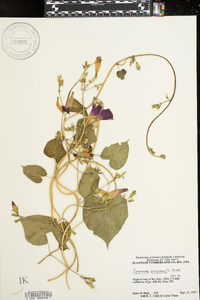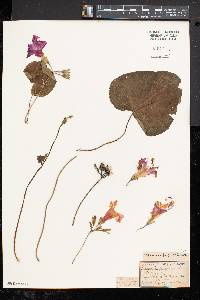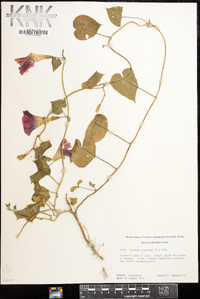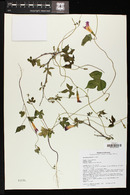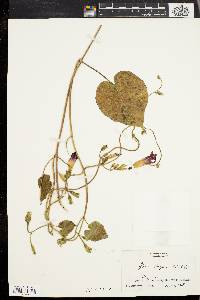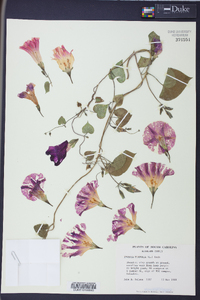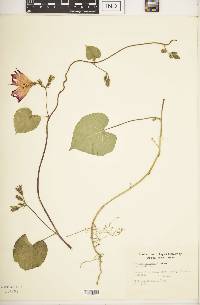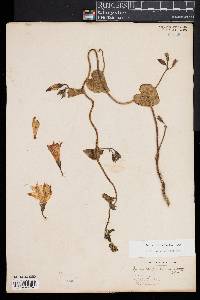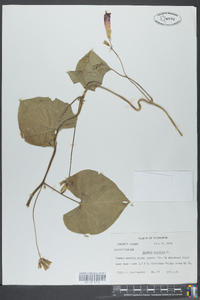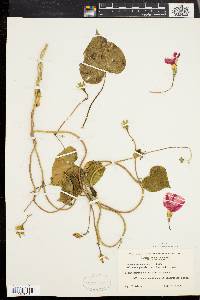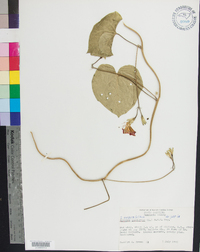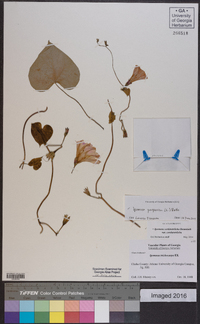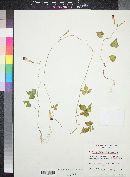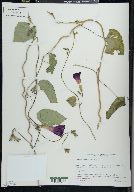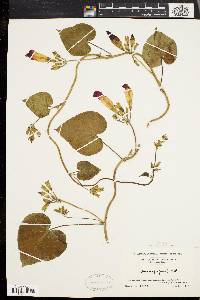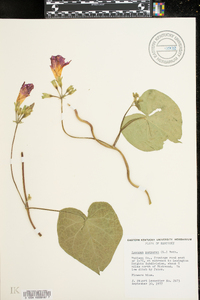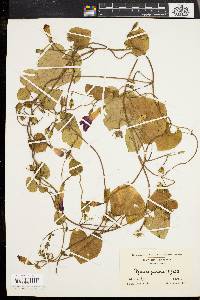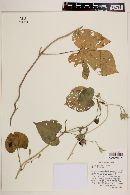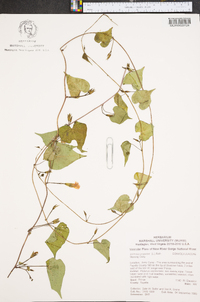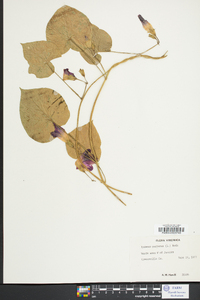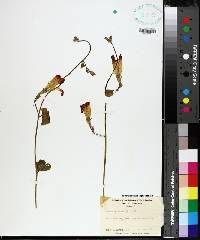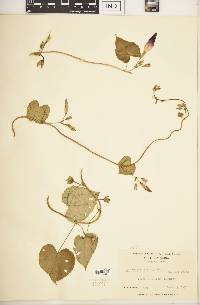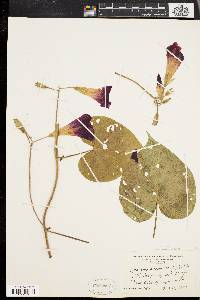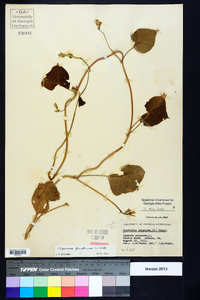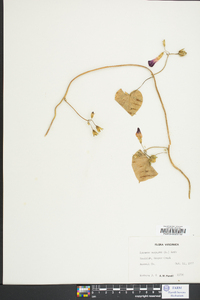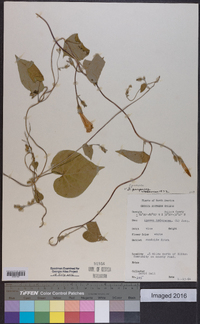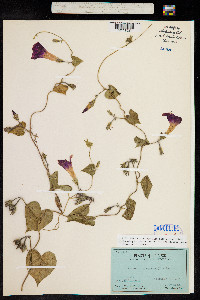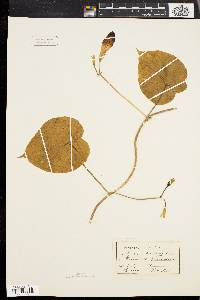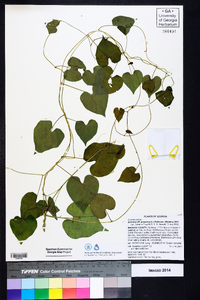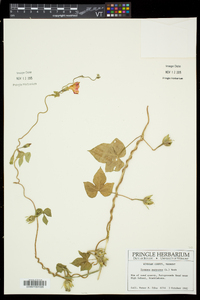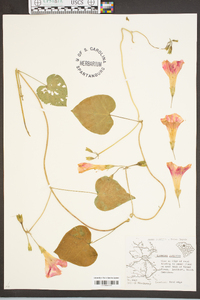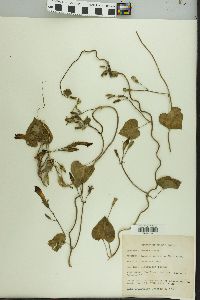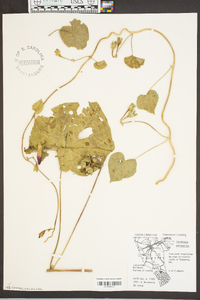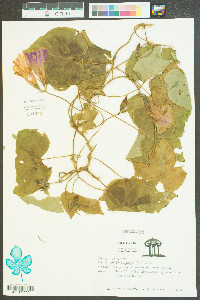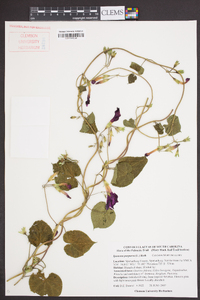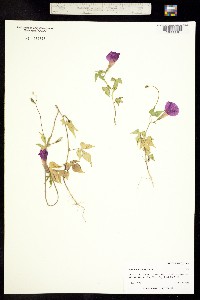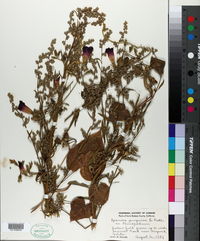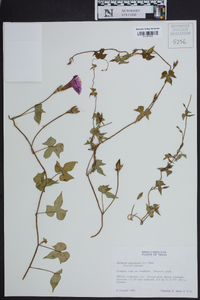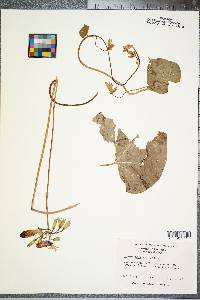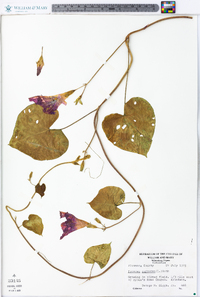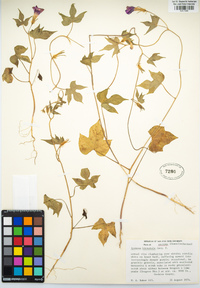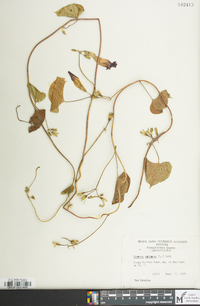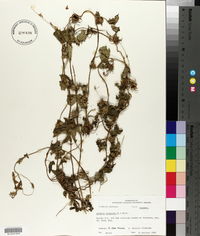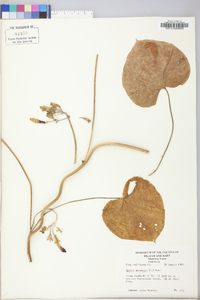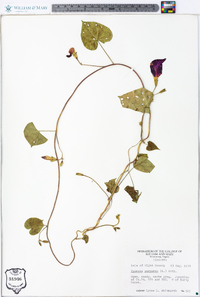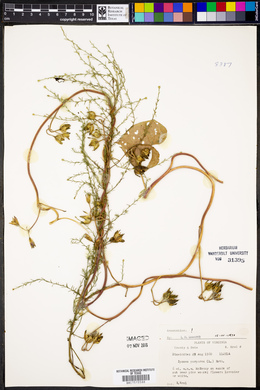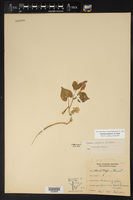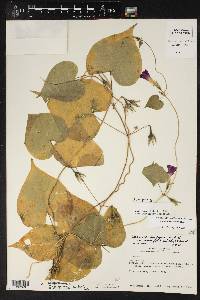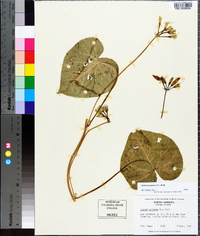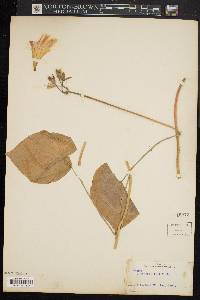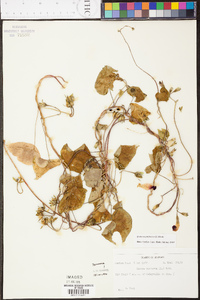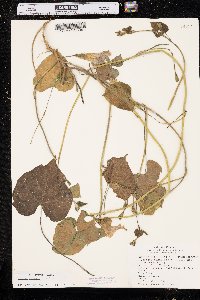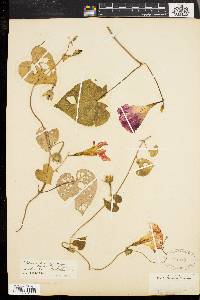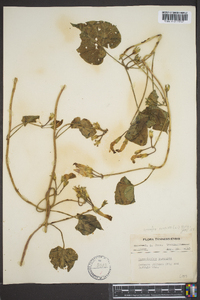
|
|
|
|
Family: Convolvulaceae
Common Morning-Glory, more...tall morning-glory, common morning glory, common morningglory, common morninglory, tall morningglory (es: trompillo, flor azul, aurora, campanilla, manto)
[Convolvulus purpureus L., moreIpomoea diehlii M. E. Jones, Ipomoea hirsutula Jacq. f., Ipomoea purpurea var. diversifolia (Lindl.) O'Donell, Pharbitis purpurea (L.) Voigt] |
Plant: Annual twining vine, loosely pubescent to tomentose with short, appressed retrorse trichomes, and often with large spreading trichomes which may reach 4 mm long; stems twining, branched to simple Leaves: ovate, entire to 5-lobed, 1-11 cm long, 1-12 cm wide, the base cordate, the apex acute to acuminate, rarely obtuse, mucronate, the petioles 1-14 cm long INFLORESCENCE: (1-)2-5-flowered cymes; bracts linear to lanceolate, 1.3-9 mm long Flowers: pedicels 5-16 mm long, erect in flower, reflexed and enlarged in fruit, reaching 25 mm long; bracteoles similar to bracts, 4.5 mm long; sepals 8-15 mm long, the outer sepals narrowly ovate-lanceolate to elliptic, (1.5-)2.5-4.5 mm wide, acute to abruptly acuminate apically, more pubescent near base, the inner sepals ovate-lanceolate, 2.5-3 mm wide, acute to abruptly acuminate; corollas funnelform, 2.5-4.3(-5) cm long, blue (white to purple in cultivated plants), white within the tube, glabrous, the limb 2.4-4.8(-7) cm wide; stamens 8-10(-14) mm long, the anthers 1.5-2(-3) mm long; ovary ovoid to conic, 1.5-2 mm long, 3-locular, glabrous; style 14-22(-30) mm long; stigmas 3, globose Fruit: FRUITS globose to ovoid, 7-8(-10) mm wide, 6-valvate, the apiculum 2-4 mm long. SEEDS 3-6, 4-5 mm long, ovoid, black to dark brown, finely tomentose Misc: Disturbed sites and in cultivation; 300-2300 m (1000-7500 ft); Jul-Nov REFERENCES: Austin, Daniel F. 1998. J. Ariz. - Nev. Acad. Sci. Convolvulaceae 30(2): 61. Annual vine up to 5 m long Stem: twining and climbing very high, hairy, and if cut or broken then exuding a milky sap. Leaves: alternate, long-stalked, non-toothed, hairless or sparsely hairy, 5 - 15 cm long, broadly heart-shaped with a short pointed tip (rarely a few leaves with two or three lobes). Flowers: many, axillary, singly on long stalks (about equal to leaf stalk) or up to five in a stalked umbel-like cluster, usually blue or purple, sometimes white with blue or purple streaks, showy, 4 - 7 cm long, radially symmetric, funnel-shaped or somewhat trumpet-shaped. Sepals: five, conspicuously hairy below middle, 0.6 - 1.5 cm long, lance-shaped to narrowly egg-shaped, widest at base with pointed tip (sometimes long-pointed). Petals: five, but fused into a tube or funnel with flaring or spreading limb, which may be shallowly five-lobed or merely wavy along edges. Stamens: five, attached to inside base of petal tube, not extending beyond petal tube. Pistil: with one, three-chambered, superior ovary; a single style shorter than the petal tube; and one stigma with three small, rounded lobes. Fruit: stalked, two- to four-valved, one- to three-chambered, rounded capsules with two seeds per chamber. Similar species: Ipomoea purpurea is most similar to I. hederacea, except that species usually has three-lobed leaves, and the sepals exceed 1.5 cm long and have very long, linear, pointed and recurved tips. Other species of Ipomoea in our area have hairless sepals (or sometimes with a few bristles on the edges), white flowers (or some with purple or red coloring in the throat), and only two-lobed stigmas. Flowering: August to October Habitat and ecology: Introduced from tropical America as an ornamental, somewhat common as a weed of cultivated lands and also in waste ground. Occurence in the Chicago region: non-native Notes: This species is the commonly planted garden morning glory. Etymology: Ipomoea comes from the Greek word meaning worm-like, possibly referring to the twining and twisting stems, or the twisted flower buds. Purpurea means purple. Author: The Field Museum Wiggins 1964, Austin 1998 Duration: Annual Nativity: Non-Native Lifeform: Vine General: Annual, loosely pubescent to tomentose with short, appressed retrorse trichomes, often with large spreading trichomes which may reach 4 mm long, stems twining, branched to simple. Leaves: Blades ovate, entire to 5-lobed, 1-11 cm long, 1-12 cm wide, the base cordate, the apex acute to acuminate, rarely obtuse, mucronate, petioles 1-14 cm long. Flowers: Usually 2-5 flowered cymes, linear to lanceolate bracts, 1.3-9 mm long; pedicels 5-16 mm long, erect in flower, reflexed and enlarged in fruit, to 25 mm long; bracteoles 4.5 mm long; sepals 8-15 mm long, outer sepals narrowly ovate-lanceolate to elliptic, 2.5-4.5 mm wide, acute to abruptly acuminate apically, more pubescent near base, inner sepals ovate-lanceolate, 2.5-3 mm wide, acute to abruptly acuminate; funnelform corollas 2.5-4.3 cm long, blue, white within tube, glabrous, limb 2.4-4.8 cm wide. Fruits: Globose to ovoid capsule 7-8 mm wide. Ecology: Found in disturbed sites and in cultivated areas; 1,000-7,500 ft (305-2286 m); flowers from July-November. Distribution: Introduced to much of N. Amer.; in the US from OR south to CA, east to ME and Quebec CAN; south through the W. Indies; MEX, C. Amer., S. Amer.; also on every continent in the Old World. Notes: Introduced weed, highly variable species, largely due to cultivated selection. Distinguished from other regional Ipomoea by being hairy with appressed hairs facing downwards on leaves and stems, some of these becoming long; leaves entire and heart-shaped to shallowly divided into 3-5 lobes; sepals broad then abrupt to a sharp point (as opposed to other species, see their descriptions) and with spreading hairs. Ethnobotany: Unknown Etymology: Ipomoea comes from Greek ips, a worm and homoios, like, referring to plant-s habit, purpurea means purple. Synonyms: Convolvulus purpureus, Ipomoea hirsutula, I. purpurea var. diversifolia, Pharbitis purpurea Editor: SBuckley 2010, FSCoburn 2015 Annual; stems pubescent, to 5 m; lvs round-cordate to ovate-cordate, entire (very rarely 3-lobed), abruptly short-acuminate or merely apiculate, glabrous to sparsely hairy; peduncles nearly or quite equaling the subtending petioles, 1-5-fld; sep lance-ovate to oblong, acute or acuminate, hirsute toward the base, commonly 10-15 mm; cor blue, purple, white, or variegated, 4-6 cm; ovary 3-locular; stigma 3-lobed; 2n=30. Native of trop. Amer., escaped from cult. and now a weed in fields, roadsides, and waste places in much of our range. July-Sept. (Pharbitis p.) Gleason, Henry A. & Cronquist, Arthur J. 1991. Manual of vascular plants of northeastern United States and adjacent Canada. lxxv + 910 pp. ©The New York Botanical Garden. All rights reserved. Used by permission. From Flora of Indiana (1940) by Charles C. Deam Reported as an escape from all parts of the state. I have seen it as a pernicious weed in cornfields in several counties. I have not collected it as often as I saw it; so our map does not indicate its frequency in the state. The leaves of this species are sometimes 3-lobed. …… Indiana Coefficient of Conservatism: C = null, non-native Wetland Indicator Status: FACU |
|
|
|

